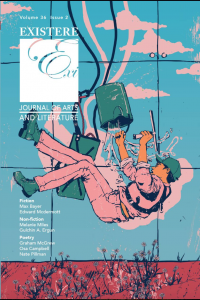
A lot of this issue’s work has to do with transparency. It is more than a need to expose, but a need to frame thoughts and experiences through a lens that encouages conversation. This exposition is not accusatory by nature, however, it embodies the sort of awareness that truly highlights the writing, at least where the subject matter is concerned.
One story, Max Bayer’s "Nurse," explores a situation in the 1800’s where the protagonist (the daughter of a white man and a black woman) shifts identities. She is taught to be white, then masquerades as a male to enlist in the army, is discovered as coloured, and then discovered further as a woman. We watch her roles change with these identities, and we experience the narrative through the lenses of those who categorize her.
Another story, Edward McDermott’s "Broken," puts us in the head of a terminal patient who learns to comfort others while coping with his own mortality. We think he is okay with it when the story begins, but we learn he has his own natural insecurities. His story is framed through the other characters that aim to help him through his struggle.
I wonder what experience the writers of both these pieces have with regards to the subject matter, as I often wonder with any story I read. I tend to ignore the About the Author page on the back of novels I finish, because I feel that it kills the illusion, that it forces me to frame the story within the lens of the writer, although this largely applies to fiction. With non-fiction, the added narrative of the writer helps us envision the writing; at the very least it gives us closure. With poetry and art portfolios—two arguably abstract forms of art—information supplied by the author works likes clues to help unlock the work, to help us understand it better.
With fiction, the role of the writer is minuscule until we read their bio—immediately we’re flooded with our own assumptions, both of the work and the writer themselves. We think, “Who is this writer to write of such things, what experience do they have, what research have they done?”
Thinking now as the writer rather than the reader, I’ve come to accept the implications certain subjects tend to promise. Our art is often encouraged by both those who impose their opinions upon them. Obviously not while we’re writing them, but in the step that comes after, the step that really makes or breaks the writing, the shared conversation between the writer and the reader, or the reader and the reader, or the writer and a writer. The writing matures with these conversations, and it is in these conversations, these frames, that we learn what it means to be the person behind the art, the person that imagines, that builds a mound of story from nothing and then sculpts it into shape.
Transparency behind the person who created the art does more than advertise the rest of their work, it influences the way we perceive it, and sets us up in a way the artist may have anticipated in the first place.
Writers in order of appearance:
Sara Wilson
John Ballantine
Graham McGrew
Max Bayer
Katherine Barrett
Nate Pillman
Marlon Brandon
Karen Fayeth
Amber Higgins
Gulchin A. Ergun
Osa Campbell
Maureen Alsop
Edward McDermott
Melanie Miles
Jennifer Ouellette
Stephen Brown
Artists in order of appearance:
Allen Forrest — Portfolio
Giada Cattaneo — Portfolio
Manahil Bandukwala — Portfolio
Editorial:
Mustapha Safadieh
Reviews in order of appearance:
Review of André Narbonne’s You Were Here by Lauren Dick
Review of Kate Taylor’s Serial Monogamy by Mahdis Habibinia
Review of M. Travis Lane’s Heart On Fist by Alvin Wong
Available through order forms.
Please send any order forms to our mailing address, available on our "Contact Us" page.

